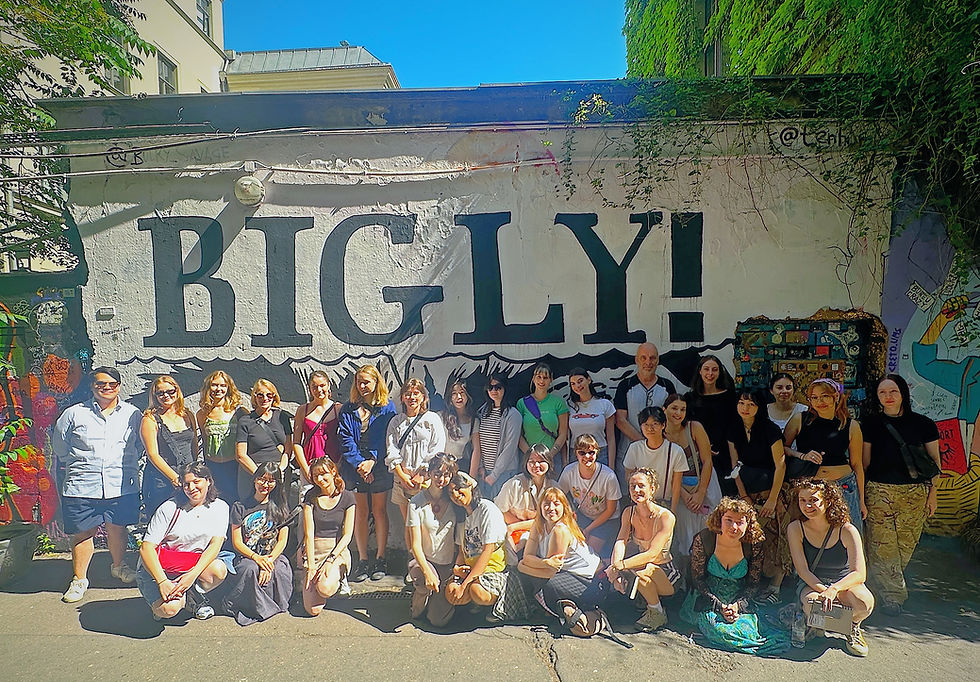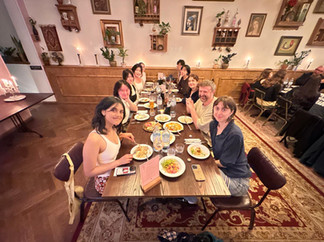It never rains in Berlin: An insight into Berlin’s art, history, and culture by Georgia Tutt
- ART HISTORY

- Sep 18
- 6 min read
Georgia Tutt was the student Digital Media Ambassador for the Art History Berlin fieldwork in July 2025.
Resistance is clearly seen in the graffiti-drenched walls, the abundance of museums and galleries, and a culture made up of those determined to be free and accepting. Seeing it through the lens of art history truly opened my eyes to how art and the world interact and influence each other. Bringing back this perspective and way of viewing art history has drawn my study to be more intentional and worldly, taking in the multitude of viewpoints and shared histories.

Prior to departing on this trip, I undertook some very basic research into the city of Berlin. A Google search for information about the city of Berlin led me to ‘City Sightseeing Buses: Fun Facts about Berlin’. It was here that I learnt that ‘Berlin has more museums than it has rainy days in a year’ (190 museums versus 106 average days with rainfall). That’s a lot of museums, I thought, or perhaps a very dry climate. Eager to find out, I was beyond excited to be embarking on ARHT3681: Fieldwork: Art & The City to Berlin with Associate Professor Donna West Brett and Dr Nick Croggon for two weeks.
I can attest that in our time in Berlin, we indeed went to a lot of museums, a total of 17, in comparison to rainy days, which was one. It’s safe to say that a lot of artwork was seen and enjoyed over this trip, so to summarise it as easily as possible, I will walk you through an average ‘day in our life’ while in Berlin, as well as some insights into our itinerary.
Students engaging in conversation. Students in the Altes Nationalgalerie (taken by Donna West Brett).
As any good day should start, our mornings began with a breakfast buffet in the hotel lobby. We were staying at an Adina Apartment Hotel, an Australian-owned hotel chain which provided the utmost care and comfort. We were fueled up every morning on coffee, pretzels, fresh fruit, and a touch of home with Vegemite toast. Over our breakfast, we would chat about the day ahead, or the adventurous night before (Berlin truly does have the best nightlife), while everyone got ready and met for the morning briefing. With our own section of the hotel lobby, we had a space that operated much like an informal classroom, where Donna and/or Nick would give us a run-through of where we were going that day, why we were going there, and what to look out for.
Breakfast at the Adina. Donna and Nick leading us through Berlin streets and teaching in a gallery.
On the very first morning, Nick explained to us four key years in Berlin’s history that would help us in our understanding of how art and history interact. Starting in 1871, he explained this year as the start of the New German Empire, shown by a military victory parade to the Brandenburg Gate.
Exploring: the Berlin Wall, the Brandenburg Gate and the Reichstag Building.
This established Berlin as a city of culture, in competition with other big cities like Paris or London. Then, in 1933, the Reichstag (Parliament building) caught fire and was used by Adolf Hitler to seize more power, as he claimed was caused by the Jewish people. His dictatorship began to form. The third date, in 1945, marks when the city was surrendered to a coalition of leaders following WWII. Berlin was divided into East and West by the Berlin Wall in 1961, ruled by a coalition of Allied Forces, the United States, Great Britain, France, and Russia. The wall was upheld until 1989, our fifth year of significance, when the announcement was made that travel from East to West (and vice versa) was now allowed. Dismantling of the wall commenced, and this marked the end of Berlin and the country's division. These key dates were constantly significant in our study of Berlin’s art history as they were reflected through German artists and artworks, but also in how museums were constructed, destroyed, and rebuilt.
Then the day would truly begin, as we journeyed to our first destination. Our hotel was located in Hackescher Markt, a central and convenient area which allowed us to walk easily to Museum Island, which hosts Berlin’s five largest institutions. We visited several of these, including the Humboldt Forum, the Neues Museum, Altes Museum, Bode Museum, and the Alte Nationalgalerie. On Day 7, we were headed to the Neue Nationalgalerie, located in what was once the edge of West Berlin. This required a 20-minute bus ride, a nice way to see the streets of the city. Outside the gallery, one of our student groups presented on the history, architecture, and significance of the building, noting the contemporary architecture, which featured a flat roof, remarkably different from traditional German design.
Within and outside the Neue Nationalgalerie.
The Neue Nationalgalerie had three major exhibitions on display, as well as its permanent collection, which features modern art focused on the 20th century. The artists exhibited were Gerhard Richter, Yoko Ono, and Lygia Clark, providing a range of modern and contemporary paintings, installations, and interactive works. What was most loved about this museum by myself and many other students, was their intentional curation in presenting their collection. The space was currently themed around ‘Art after 1945’, and followed a timeline of significant events in Germany and the world through the Cold War. This featured pieces from notably well-known artists, such as Andy Warhol, Mark Rothko, Pablo Picasso, Francis Bacon, and many more. I was particularly drawn to Gerhard Richter’s exhibition ‘100 Works for Berlin’, which showed some of his most notable pieces, including Birkenau (2014).

Birkenau. Photo: © SPK / photothek.net / Xander Heinl
This series consists of four large-format, abstract paintings that are based on photographs taken in the concentration camp Auschwitz-Birkenau. Richter transposed these with charcoal and oil paint before gradually painting over them in an abstract way. What is left is a fragmented display of the original image, calling viewers to question what they are really looking at.
After a few hours of roaming, note-taking, and absorbing, we were ready for lunch. Our breaks were free for us to explore, relax or enjoy the museum cafes overpriced and mediocre coffees (Australian coffee really is superior). This was a great time to chat and de-brief about what we liked and didn’t like, and any connections we were finding in our study. Our afternoons greatly differed based on the itinerary, with some being another museum or gallery, and others free for our own activity. When we did have free afternoons, often many of us organised to transit to another part of Berlin, with the mission to hunt down as many vintage stores as possible. We found designer vintage boutiques, massive op shops, and per-kilo halls of vintage clothing. It’s safe to say our luggage grew in size, while our wallets got a lot smaller. As it approached the evening, dinner plans were made - usually taking advantage of the late sunset for spending as much time outdoors as possible. Some evenings involved drinks at a beer garden, or card games in the hotel lobby, or perhaps a quiet night in to rest for the next day ahead.
Exploring Berlin in our free time.
Over the two weeks, the content of the trip covered artwork ranging from ancient Greek and Egyptian times to contemporary works made for the Berlin Biennale. Whether it was the Bode Museum, full of ancient religious altar paintings, or the Museum of Photography, which focused on the controversial work of Helmut Newton, Donna and Nick were there to guide us with new insights and ideas. It was great to finish with an insight into what artists and commercial galleries are producing in Berlin, as a cultural capital of fine contemporary art.
Students engaging in the museums.
Berlin truly is a magical city, especially when lit in the summer evening light. A city full of people embracing life and freedom after a tainted history of confinement and censorship. Resistance is clearly seen in the graffiti-drenched walls, the abundance of museums and galleries, and a culture made up of those determined to be free and accepting. Seeing it through the lens of art history truly opened up my eyes to how art and the world so clearly interact and influence each other. Bringing back this perspective and way of viewing art history has drawn my study to be more intentional and worldly, taking in the multitude of viewpoints and shared histories.
I urge all and any art history students to consider embarking on a fieldwork trip as it truly is invaluable knowledge and experience. There is nothing quite like doing what you love surrounded by 30 other students who share that enthusiasm and passion and I am truly grateful for all the conversations had and friendships made. I look forward to returning to Berlin one day to visit the remaining 173 museums. And according to my calculations, about 50 days of rainfall per year.
A big thank you to Donna West-Brett, Nick Croggon, G Short (our Sydney Abroad Mobility Officer), Charlie Tapper, Academy Travel, and everyone else involved in the planning of this trip.
From our farewell dinner. Photos by Donna West Brett.
Words and pictures by Georgia Tutt unless otherwise marked. (Thank you Georgia)
References:
City Sightseeing Berlin, ‘15 fun facts about Berlin’, City Sightseeing, 29th January 2024,






























































Comments